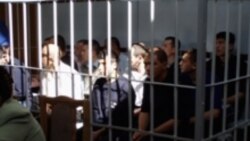One of the defendants, Tavakalbek Hojiev, said yesterday that the U.S. Embassy in Tashkent financially supported the uprising. He did not provide any evidence but said he was informed about the fact by another man -- Qobiljon Parpiev -- whom the Uzbek government has accused of helping instigate the violence.
"He [Parpiev] told me that the U.S. Embassy has allocated the money [for the uprising.]" Hojiev said. "And if our action in Andijon would not succeed we had to leave for Kyrgyzstan. He said that this was the plan. According to this plan, we left for Kyrgyzstan."
Parpiev was among the protesters who seized the regional administration building in Andijon on 13 May. He escaped when Uzbek forces opened fire on protestors, and fled the country.
Hojiev said the aim of foreign countries allegedly assisting the revolt was to overthrow the Uzbek government by provoking a "colored revolution."
U.S. State Department spokesman Sean McCormack, speaking yesterday at a news briefing in Washington, denied any links between the U.S. Embassy in Tashkent and the Andijon unrest.
"With respect to Andijon, we continue to support an independent, international inquiry," McCormack said. "As for Embassy involvement in this tragic incident, this has come up before and there's just no basis for it."
Alex Vatanka, the Eurasia editor of the London-based publication "Jane's Country Risk," told RFE/RL that allegations about U.S. involvement in Andijon are not convincing.
"How the American Embassy could have been that catalyst for that [Andijon unrest], or anybody else -- external forces? -- is beyond me," Vatanka said. "I just could not see that happening, and I think it is really [incredible]. We are getting ourselves into a sort of Central Asian conspiracy theories and so on."
The United States is not the only country accused of being behind the events in Andijon.
Three defendants -- all ethnic Uzbeks with Kyrgyz citizenship -- said yesterday that they received training at a camp in Kyrgyzstan. One of them, Jahongir Burkhanov, said one of the instructors was a red-haired, blue-eyed Chechen named Mamed who taught them how to operate weapons and dig trenches.
"Three of us were brought to a firing range in Teke (a village in the Osh region of Kyrgyzstan)," Burkhanov said. "When we arrived, there were three strangers besides people we already knew. We greeted them and (alleged militant) Akrom Mamadaliev introduced them to us. One of them was named Mamed. He had red hair, blue eyes, and a beard. Then Akrom Mamadaliev told that man (Mamed) and another man to train us. Then we stepped into a room and Mamed showed us how to disassemble and assemble [a weapon]."
Kyrgyz authorities have refuted any efforts to link Kyrgyzstan to the events in Andijon.
Vatanka said it is a practice of the Uzbek authorities to look for enemies outside the country. But he said that the biggest problem is the lack of democracy in Uzbekistan itself.
"That comes down to one issue and that's the fact that the regime is not representative," Vatanka said. "It is seen as repressive. Things of this nature (the violence in Andijon) will simply happen. You can blame it or not on outsiders and hope it will go away, but the fact is they (the problems) are not going away."
Meanwhile, human rights groups say Uzbek authorities routinely force people to make false confessions, and many groups have described the trial as an attempt to cover up what they say was a massacre of civilians by Uzbek forces.
The Andijon uprising erupted in May when militants seized a prison and freed 23 businessmen who had been on trial for alleged Islamic extremism. The attackers also seized a local administration building and took hostages. Thousands of demonstrators gathered in an adjacent square to press economic and social grievances.
Human rights groups and refugees who fled to Kyrgyzstan claim that the revolt led to a brutal government crackdown that led to the deaths of more than 700 people, mostly civilians who were shot while trying to flee the square.
The Uzbek government of President Islam Karimov says that 187 people died, mostly militants.









